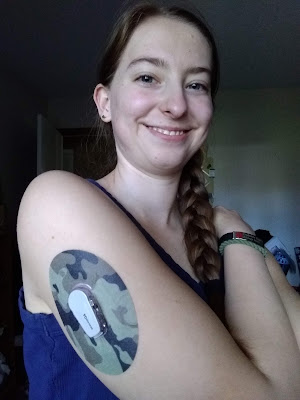 |
| This is what breakfast looked like . . .until I discovered rice milk causes my blood sugar to spike. |
I left the hospital with slightly more information on the topic of diabetes than I had before my diagnosis. I understood that I was on a carb-controlled diet with insulin injections. However, I had no idea what foods did or did not have carbs. I didn't know what a ratio was or a correction dose. The next few days involved many frustrated tears as I adjusted to the unknown.
In the hospital I learned how to take my blood sugar with a lancet (finger-pricker). However, I had no idea what was high or what was low. Well, I knew 700 mg/dl was too high and I was spending most of my time around 200 mg/dl. Pricking my finger proved challenging at first. I would reflexively pull my finger away from the lancet. On top of that difficulty, I experience Raynaud's syndrome in my fingers and toes. My capillaries decide to pinch off when I'm cold or stressed. It makes it much harder to produce enough blood to test my sugars! By reading my discharge papers, I discovered that I was on a 1:12 ratio, meaning I inject one unit of insulin for every 12 grams of carbs I eat. Baby steps!
Above you can see my rapid-acting insulin: Novolog. I inject this insulin with every meal. This is referred to as my bosal. My basal insulin is Basaglar, slow-acting insulin which I inject every night before bed. It didn't take me long to discover several benefits of diabetes. I have been a picky eater, but diabetes has pushed me to try new foods that I would otherwise avoid. My new understanding of carbs, protein, fat, and fiber encourages me to create more diverse meals than before. As my diabetic educator said, "There is no diabetic diet. There is just a healthy diet - and everyone should be on it!"
I invested in a little bag designed to hold insulin pens and supplies as well as a journal designed to keep record of sugars and insulin, exercise and hydration, sleep and stress. Thanks to my endocrinologist, I switched from daily finger pricks to my favorite device ever!
Meet Dexy: my bionic bit. The Dexcom G6 is a Continuous Glucose Monitor (CGM) that stays inserted in my arm for 10 days. It automatically takes my blood sugar every five minutes, sending the data to a handheld receiver. It comes with the option to use a cell phone instead of the receiver, but my current phone isn't compatible with the app (Hey Dexcom, add Motorolas to your list of compatible devices please!).
The sensor comes in an applicator that uses a needle to insert a tiny strip of metal (I think it's metal . . . that's what it looks like) into my body. The needle then retracts into the applicator. It's a relatively painless procedure, no worse than a finger prick. Once inserted, I can't feel the sensor strip at all. Below is a picture of my first Dexcom sensor after I removed it.
Right now I'm slowly working through the process of learning and adjusting. I've learned so much in the last two months, but I have a lot left to learn. The pancreas is beautifully and wonderfully made. I am not yet good at being my own pancreas (I ate almost four hours ago and I'm still at 210 mg/dl). Insulin is a hormone, so the way each individual's body interacts with it is truly unique. Many people find hot temperatures lower blood sugar, but after spending a few days in Oregon, I'm finding that time in the sun seems to raise my blood sugar. For the next year, I'll be educating myself and developing an understanding of my body. It's a lifelong journey, but I hear that the first year is the most difficult.











Thanks for sharing your story! It has to be so hard to be diagnosed as an adult. I don't have diabetes, but my best friend (Connor's Aunt Mary on my blog) got diagnosed with T1D as a toddler, and after we roomed together in college I got very used to it. She's EXCEPTIONALLY on top of her sugars and has learned all kinds of tips and tricks for dealing with it as a result of growing up with a nurse mom that had two T1D kids (plus they both had Celiac as well!). I know you don't really know either of us, but if you ever need a fellow T1D equestrian to talk to, Mary would be happy to lend an ear and her help.
ReplyDeleteThank you! I will reach out if I have any questions. I am planning to be very on top of my sugars as soon as possible, but I'm also learning to give myself grace as I learn and adjust. :)
Delete